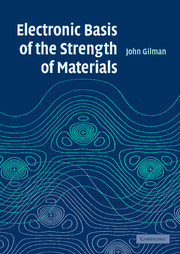Book contents
- Frontmatter
- Contents
- Preface
- Section I Introduction
- Section II Elements of solid mechanics
- Section III Elements of electron mechanics
- Section IV Elastic stiffness
- Section V Plastic strength
- Section VI Fracture resistance
- 19 Mechanics of cracks
- 20 Surface and interfacial energies
- 21 Fracturing rates
- Index
- References
21 - Fracturing rates
Published online by Cambridge University Press: 14 August 2009
- Frontmatter
- Contents
- Preface
- Section I Introduction
- Section II Elements of solid mechanics
- Section III Elements of electron mechanics
- Section IV Elastic stiffness
- Section V Plastic strength
- Section VI Fracture resistance
- 19 Mechanics of cracks
- 20 Surface and interfacial energies
- 21 Fracturing rates
- Index
- References
Summary
Introduction
Most fracture is athermal, either because it occurs at low temperatures, or because it occurs too fast for thermal activation to be effective. Thus it must be directly activated by applied stresses. This can occur via quantum tunneling when the chemical bonding resides in localized (covalent) bonds. Then applied stresses can cause the bonding electrons to become delocalized (anti-bonded) through quantum tunneling. That is, the bonds become broken. The process is related to the Zener tunneling process that accounts for dielectric breakdown in semiconductors. Under a driving force, bonding electrons tunnel at constant energy from their bonding states into anti-bonding states. They pass through the forbidden gap in the bonding energy spectrum.
Thermal activation
At elevated temperatures, the process known as stress-rupture occurs. It is a result of thermally activated vacancy motion. It will not be discussed in detail here. In order for atoms to move from one atomic site in a crystal to another, the temperature must be relatively high, usually above the Debye temperature where the vibrations of individual atoms are excited, and vacancies can be thermally generated. The relatively large masses of atoms prevent much activity at lower temperatures.
The mass of an electron is 1/2000 times smaller than the mass of the smallest atomic nucleus, the proton. It is about 1/20 000 times lighter than a carbon atom, and 1/200 000 times lighter than a molybdenum atom.
- Type
- Chapter
- Information
- Electronic Basis of the Strength of Materials , pp. 267 - 276Publisher: Cambridge University PressPrint publication year: 2003



